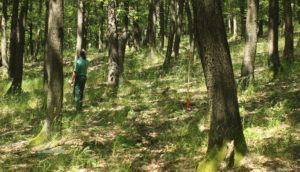General description of project area
Name of the project area: Garábi Varjú-bérc
Surface area (ha): 42.390
EU protection status SPA: NATURA 2000 Code HUBN20056
EU protection status SCI: –
Other protection status according to national or regional legislation: East-Cserhát Landscape Protection Area
The main uses of the project site: The main land uses: Nature conservation 100%
The ownership status: Sate property 100%

Scientific description of project area
The area is located 400-450 m a.s.l. on andesite bedrock. The N and W sides of the hill are covered by 67-82 years old natural forests of 91G0*Pannonic woods with Quercus petraea and Carpinus betulus (42%), 91M0 Pannonian-Balkanic turkey oak –sessile oak forests (27%) and some transition 91G0* forests (21%). The landscape around it comprises forests, maintained and abandoned grasslands. The rocky ridge is covered by 40A0*Subcontinental peri-Pannonic scrub (0,2%). The clearings of the forests are covered with 6240*Sub-Pannonic steppic grasslands (0,7%). There are some 9180 * Tilio-Acerion forests on slopes, screes and ravines (4%). Some invasive Robinia a pseudoacacia (1,4%) can also be found on the project site. The botanical values are Allium paniculatum, Dryopteris dilatata, Echium russicum, Pulsatilla grandis and Thlaspi jankae.
Animals of the area:
- Mammals: Felis sylvestris, Nyctalus noctula, Glis glis
- Birds: Columba oenas, Dryocopus martius, Dendrocopos medius, Ficedula albicollis, Picus canus, Strix
aluco and Turdus viscivorus - Beetles: Cerambyx cerdo, Lucanus cervus and Probaticus subrugosus
- Butterflies: Dioszeghyana schmidtii, Eriogaster catax, Lycaenea dispar, Pammene
querceti, and Parnassius mnemosyne
Importance of the project area for biodiversity and/or for the conservation of the species /habitat types targeted at regional, national and EU level
Biodiversity is significant, with several rare and valuable plant and animal species. These are biogeographically important, habitat-specialist species with strong populations in the area. The different oak forest stands (91G0, 91M0,) are very important habitats of several strictly protected species listed in the scientific description part, hence a proper nature conservation management of the oak forests is required. The age, stand structure, composition, mixture rate and dead wood of Pannonic woods with Quercus petraea and Carpinus betulus, Pannonian woods with Quercus pubescens and Pannonian-Balkanic turkey oak –sessile oak forests of the area, the presence of Subcontinental peri-Pannonic scrub and Sub-Pannonic steppic grasslands makes the area important in biodiversity and EU point of view. The naturalness and biological diversity of the area can be relatively quickly improved by eliminating the invasive species and applying proper nature conservation management.
Flagship species in project area
Anguis colchica, Picus canus, Barbastella barbastellus